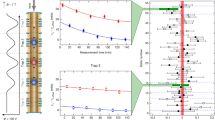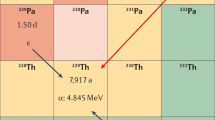Abstract
A small proportion of atomic nuclei can form highly excited metastable states, or isomers. Of particular interest is a class of isomers found in deformed axially symmetric nuclei; these isomers are among the longest-lived and have the potential to reach the highest energies. By probing their properties, insights into nuclear structure have been gained. The possibility of stimulated isomer decay may ultimately lead to new forms of energy storage and γ-ray lasers.
This is a preview of subscription content, access via your institution
Access options
Subscribe to this journal
Receive 51 print issues and online access
$199.00 per year
only $3.90 per issue
Buy this article
- Purchase on Springer Link
- Instant access to full article PDF
Prices may be subject to local taxes which are calculated during checkout






Similar content being viewed by others
References
Hansen, P. G., Jensen, A. S. & Jonson, B. Nuclear halos. Annu. Rev. Nucl. Part. Sci. 45, 591–634 (1995).
Nolan, P. J. & Twin, P. J. Superdeformed shapes at high angular momentum. Annu. Rev. Nucl. Part. Sci. 38, 533–562 (1988).
Hofmann, S. New elements—approaching Z = 114. Rep. Prog. Phys. 61, 639–689 (1998).
Audi, G., Bersillon, O., Blachot, J. & Wapstra, A. H. The Nubase evaluation of nuclear and decay properties. Nucl. Phys. A 624, 1–124 (1997).
Meitner, L. & Frisch, O. R. Disintegration of uranium by neutrons: a new type of nuclear reaction. Nature 143, 239–240 (1939).
Britt, H. C. Properties of fission isomers. At. Data Nucl. Data Tables 12, 407–417 (1973).
de Voigt, M. J. A., Dudek, J. & Szymanski, Z. High-spin phenomena in atomic nuclei. Rev. Mod. Phys. 55, 949–1046 (1983).
Byrne, A. P. et al . 34 µs isomer at high spin in 212Fr: evidence for a many-particle octupole coupled state. Phys. Rev. C 42, R6–R9 (1990).
Lobner, K. E. G. Systematics of absolute transition probabilities of K-forbidden gamma-ray transitions. Phys. Lett. B 26, 369–370 (1968).
Wheldon, C. et al . Opening up the A ≈ 180 K-isomer landscape: inelastic excitation of new multi-quasiparticle yrast traps. Phys. Lett. B 425, 239–245 (1998).
Kondev, F. G. et al . Configuration changes and hindered decays in four- and six-quasiparticle isomers in 178Ta. Phys. Rev. C 54, R459–R463 (1996).
Gjorup, N. L. et al . Seven and nine quasi-particle K-isomers in 175Hf. Zeit. Phys. A 337, 353–354 (1990).
Proceedings of the International Workshop on Physics with Radioactive Beams. (eds Sinha, B., Shyam, R. & Thompson, I. J.) J. Phys. G 24, 1309–1656 (1998).
Khoo, T. L. & Lovhoiden, G. Structural changes in the yrast states of 178Hf. Phys. Lett. B 67, 271–274 (1977).
Boos, N. et al . Nuclear properties of the exotic high-spin isomer 178Hf m 2from collinear laser spectroscopy. Phys. Rev. Lett. 72, 2689–2692 (1994).
Deylitz, S. et al . Inelastic deuteron scattering from the high-spin isomer 178Hf m 2(16+). Phys. Rev. C 53, 1266–1272 (1996).
Aberg, S. An investigation of yrast traps in some prolate Hf isotopes. Nucl. Phys. A 306, 89–100 (1978).
Jain, K., Walker, P. M. & Rowley, N. Residual interactions in multi-quasiparticle states. Phys. Lett. B 322, 27–32 (1994).
Dracoulis, G. D. Trends in nuclear structure with heavy ions. Nucl. Instrum. Methods Phys. Res. A 382, 1–19 (1996).
Mullins, S. M. et al . Rotational band on the 31 yr 16+ isomer in 178Hf. Phys. Lett. B 393, 279–284 (1997).
D'Alarcao, R. et al . High-K isomers in neutron-rich hafnium nuclei at and beyond the stability line. Phys. Rev. C 59, R1227–R1231 (1999).
Cocks, J. F. C. et al . Observation of octupole structures in radon and radium isotopes and their contrasting behavior at high spin. Phys. Rev. Lett. 78, 2920–2923 (1997).
Dasso, C. H., Pollarolo, G. & Winther, A. Systematics of isotope production with radioactive beams. Phys. Rev. Lett. 73, 1907–1910 (1994).
Grzywacz, R. et al . Identification of µs-isomers produced in the quasifragmentation of a 112Sn beam Phys. Lett. B 355, 439–446 (1995).
Pfutzner, M. et al . New isotopes and isomers produced by the fragmentation of 238U at 1000 MeV/nucleon. Phys. Lett. B 444, 32–37 (1998).
Bohr, A. & Mottelson, B. R. Rotational states in even-even nuclei. Phys. Rev. 90, 717–719 (1953).
Burson, S. B., Blair, K. W., Keller, H. B. & Wexler, S. The radiations from hafnium. Phys. Rev. 83, 62–68 (1951).
Bohr, A. & Mottelson, B. R. Nuclear StructureVol. II (Benjamin, New York, (1975).
Bardeen, J., Cooper, L. N. & Schrieffer, J. R. Theory of superconductivity. Phys. Rev. 108, 1175–1204 (1957).
Belyaev, S. T. Effect of pairing correlations on nuclear properties. Mat. Fys. Medd. Dan. Vid. Selsk. 31(11), 1–55 (1959).
Shimizu, Y. R., Garrett, J. D., Broglia, R. A., Gallardo, M. & Vigezzi, E. Pairing fluctuations in rapidly rotating nuclei. Rev. Mod. Phys. 61, 131–168 (1989).
Purry, C. S. et al . Rotation of an eight-quasiparticle isomer. Phys. Rev. Lett. 75, 406–409 (1995).
Dracoulis, G. D., Kondev, F. G. & Walker, P. M. Pairing reduction and rotational motion in multi-quasiparticle states. Phys. Lett. B 419, 7–13 (1998).
Burglin, O. & Rowley, N. Exact pairing calculations in a large Nilsson-model basis: comparison with BCS and Lipkin-Nogami methods. Nucl. Phys. A 602, 21–40 (1996).
Pashkevich, V. V. & Frauendorf, S. Effect of the shell structure on the moment of inertia; behavior of the averaged moment of inertia. Sov. J. Nucl. Phys. 20, 588–592 (1975).
Frauendorf, S. in Proc. Workshop on Gammasphere Physics 272–283 (World Scientific, Singapore, (1995).
von Weizsacker, C. F. Metastable Zustande der Atomkerne. Naturwissenschaften 24, 813–814 (1936).
Blatt, J. M. & Weisskpof, V. F. Theoretical Nuclear Physics(Wiley & Sons, New York, (1952).
Bernthal, F. et al . Connection between backbending and high-spin isomers decay in 179W. Phys. Lett. B 74, 211–214 (1978).
Pedersen, J., Bjornholm, S., Borggreen, J., Kownacki, J. & Sletten, G. Intrinsic excitations as yrast structures in 179W at I ∼ 35/2 ℏ. Physica Scripta T 5, 162–164 (1983).
Chowdhury, P. et al . Decay of high-spin isomers in Os nuclei by barrier penetration. Nucl. Phys. A 485, 136–160 (1988).
Walker, P. M. et al . High-K barrier penetration in 174Hf: a challenge to K selection. Phys. Rev. Lett. 65, 416–419 (1990).
Walker, P. M. et al . Resolution of the 179W isomer anomaly: exposure of a Fermi-aligned s band. Phys. Rev. Lett. 67, 433–436 (1991).
Crowell, B. et al . Novel decay modes of high-K isomers: tunneling in a triaxial landscape. Phys. Rev. Lett. 72, 1164–1167 (1994).
Walker, P. M. et al . K-forbidden transitions from multi-quasiparticle states. Phys. Lett. B 408, 42–46 (1997).
Bengtsson, T. et al . Competition between pairing-assisted tunneling and single-particle alignment in the decay of high-K isomeric states. Phys. Rev. Lett. 62, 2448–2451 (1989).
Narimatsu, K., Shimizu, R. & Shizuma, T. γ-tunneling calculations for the decays of the K isomers in the Hf, W, Os region. Nucl. Phys. A 601, 69–88 (1996).
Walker, P. M. et al . Multi-quasiparticle and rotational structures in 179W: Fermi alignment, the K-selection rule and blocking. Nucl. Phys. A 568, 397–444 (1994).
Jain, K. et al . Multi-quasiparticle states in the mass-180 region. Nucl. Phys. A 591, 61–84 (1995).
Xu, F. R., Walker, P. M., Sheikh, J. A. & Wyss, R. Multi-quasiparticle potential-energy surfaces. Phys. Lett. B 435, 257–263 (1998).
Matinyan, S. Lasers as a bridge between atomic and nuclear physics. Phys. Rep. 298, 199–249 (1998).
Baldwin, G. C. & Solem, J. C. Recoilless gamma-ray lasers. Rev. Mod. Phys. 69, 1085–1117 (1997).
Utter, S. B. et al . Reexamination of the optical gamma ray decay in 229Th. Phys. Rev. Lett. 82, 505–508 (1999).
Shaw, R. W., Young, J. P., Cooper, S. P. & Webb, O. F. Spontaneous ultraviolet emission from 233Uranium/229Thorium samples. Phys. Rev. Lett. 82, 1109–1111 (1999).
Collins, C. B. et al . Accelerated emission of gamma rays from the 31-year isomer of 178Hf induced by x-ray irradiation. Phys. Rev. Lett. 82, 695–698 (1999).
Rowe, D. J. Nuclear Collective Motion: Models and Theory(Methuen, London, (1970).
Author information
Authors and Affiliations
Corresponding author
Rights and permissions
About this article
Cite this article
Walker, P., Dracoulis, G. Energy traps in atomic nuclei. Nature 399, 35–40 (1999). https://doi.org/10.1038/19911
Issue Date:
DOI: https://doi.org/10.1038/19911
This article is cited by
-
Collectivity and isomers in the Pb isotopes
Interactions (2024)
-
Gamma-ray spectroscopy of fission fragments with state-of-the-art techniques
La Rivista del Nuovo Cimento (2022)
-
Production of \(^{178}\)Hfm2 and a simple chemical separation method for Hf recovery
Journal of Radioanalytical and Nuclear Chemistry (2021)
Comments
By submitting a comment you agree to abide by our Terms and Community Guidelines. If you find something abusive or that does not comply with our terms or guidelines please flag it as inappropriate.



